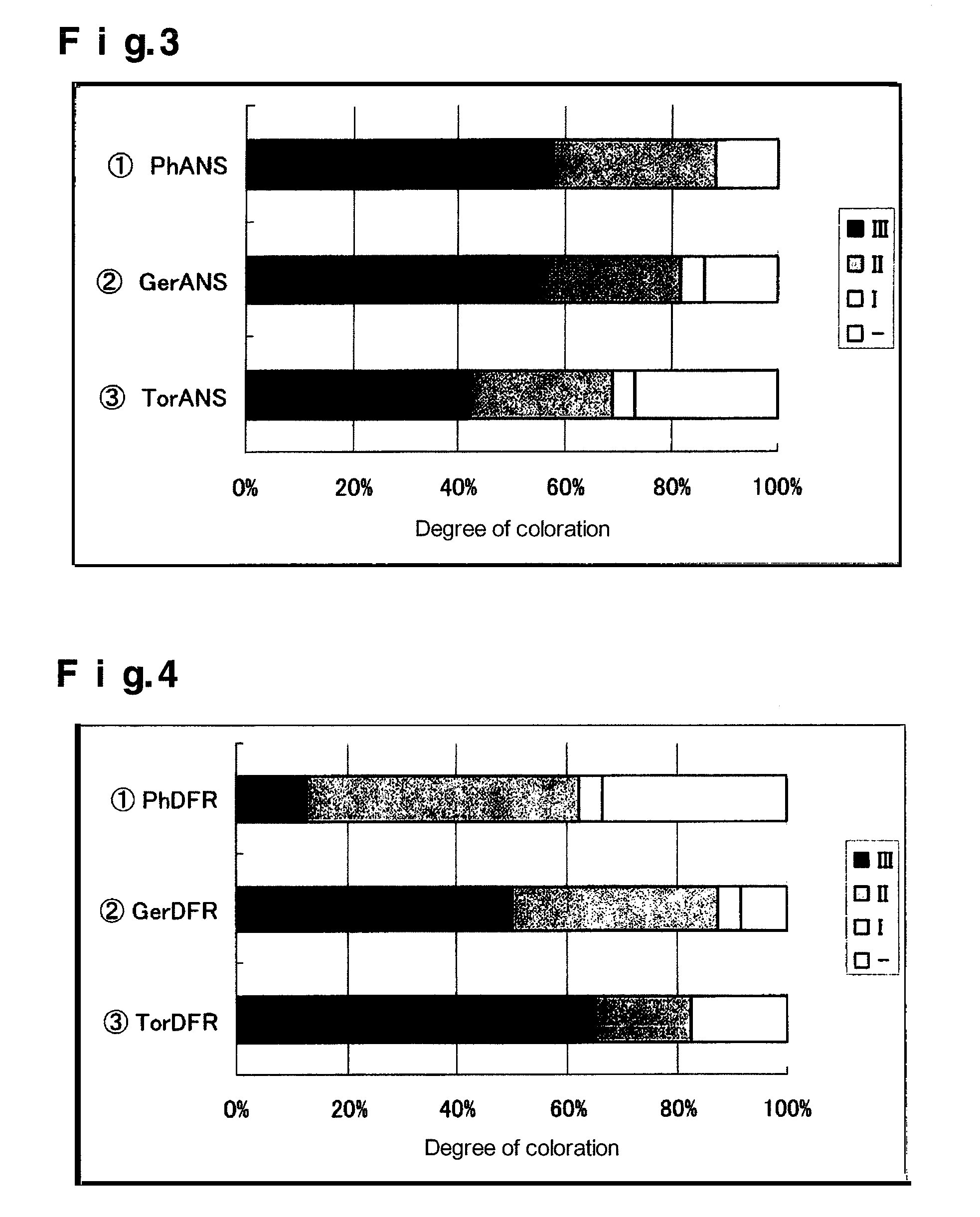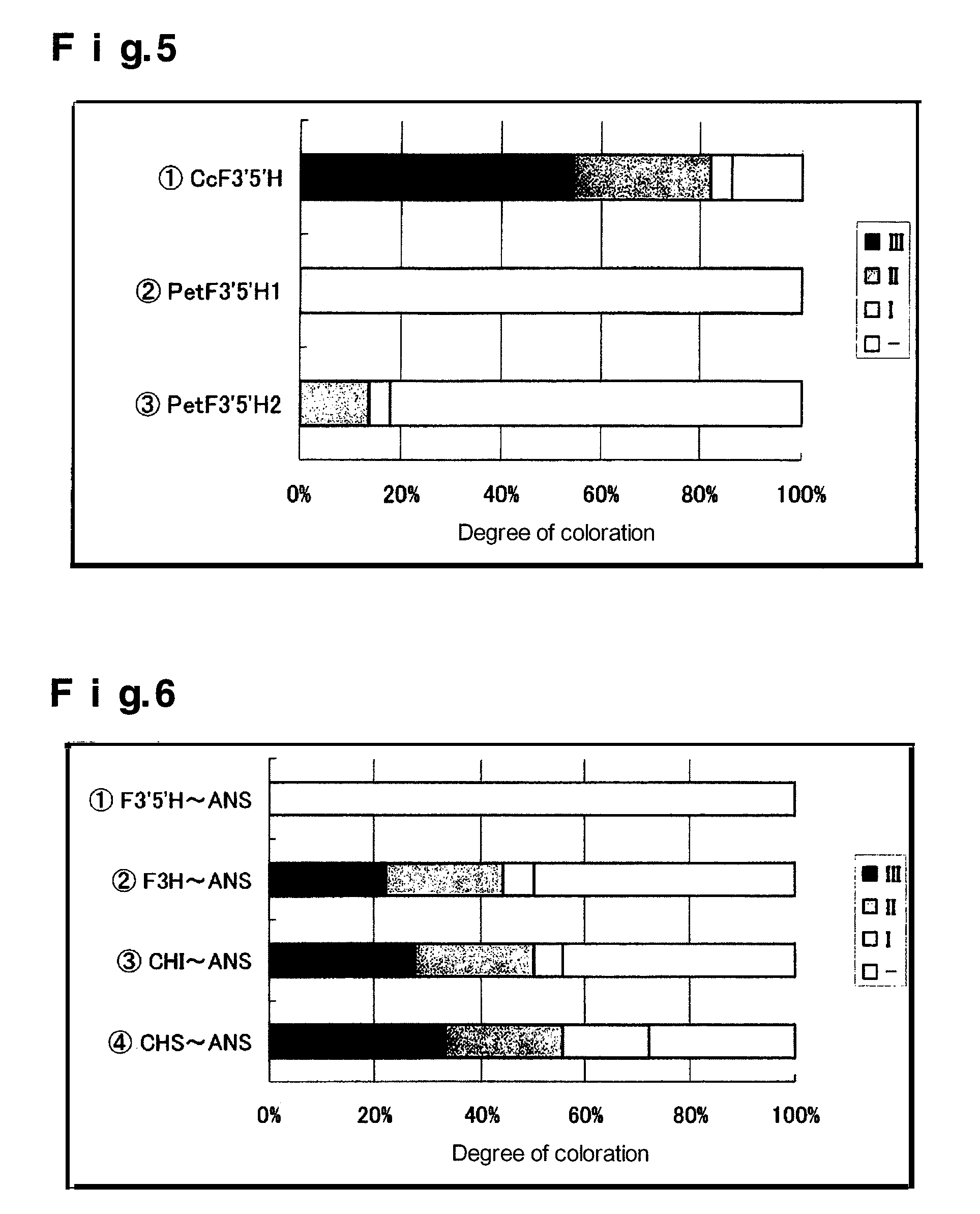Flavonoid-3',5'-hydroxylase gene of commelina communis
a technology of commelina communis and flavonoid, which is applied in the field of blue flower color production methods, can solve the problems of limited color changes, long time, and a lot of effort and tim
- Summary
- Abstract
- Description
- Claims
- Application Information
AI Technical Summary
Benefits of technology
Problems solved by technology
Method used
Image
Examples
example 1
Transfecting a Petal of Moth Orchid with a Gene
[0049]Unless otherwise specified in Examples of the present specification, a petal of moth orchid was transfected with each gene by the following gene transfection method, and its property was evaluated. All genes had a DNA structure having a promoter at 5′ side and a terminator at 3′ side and were introduced into a petal cell in the form so as to express in the cell.
[0050]A bud of moth orchid was sterilized with a 1 wt % of sodium hypochlorite aqueous solution for five minutes and washed with sterilized water 3 times. Then, the bud was resolved into a lateral sepal, dorsal sepal and petal, and the lateral sepal, dorsal sepal and petal were left on an agar medium containing New Dogashima Medium salt (Tokuhara and Mii, Plant Cell Reports (1993) 13: 7-11., hereinafter referred to as NDM salt) and 0.6 wt % of agarose. Here, in the case of Phal. amabilis, a bud having a length of about 15 mm was used, and in the case of Dtps. Queen Beer ‘Ma...
example 2
Searching and Cloning Commelina communis F3′5′H Gene (CcF3′5′H)
[0054]From a petal of a bud of the blue colored Asiatic dayflower (Commelina communis), all RNA was extracted by using RNeasy Plant Mini Kit (QIAGEN), and by using the RNA as a template, cDNA was prepared by using GeneRacer kit (Invitrogen).
[0055]Then, RT-PCR was carried out by using this cDNA as a template. Primers used for the PCR reaction were 35FH-1 (5′-ATGGTIGTIGARYTIATGAC-3′; SEQ ID No.: 3) and 35FH-4 (5′-CCRAAIGGIATIARYTCRAA-3′; SEQ ID NO.: 4) which were designed from a sequence of a conventionally known F3′5′H gene (GenBank accession No.: D14590, AJ011862, AB262585, D14589, AB078514, AY566988, D85184, AY275430, AF313490, AY675558, AB012925). In the reaction, a step of 98° C. for 10 seconds, 56° C. for 30 seconds and 72° C. for 1 minute was repeated 40 cycles. Further, Nested PCR was carried out by using an obtained reaction solution as a template and a primer 35FH-2 (5′-TGGATGGAYYTICARGGIAT-3′; SEQ ID NO.: 5) and...
example 3
Preparation of an Expression Vector (pBS-P35T35) for Gene Transfection
[0060]pBS-P35T35 is a plasmid having a cauliflower mosaic virus 35S promoter (Hohn et al., Curent Topics in Microbiology and Immunology (1982) 96: 194-236), an omega sequence of tobacco mosaic virus (Gallie et al., Nucleic Acids Research (1987) 15: 3257-3273), a restriction endonuclease SwaI site and a cauliflower mosaic virus 35S terminator in this order in pBluescriptIISK-(Stratagene) (FIG. 2). A plasmid having the substantially same function as this pBS-P35T35 can be constructed as follows.
[0061]An oligonucleotide SAS-S (5′-CTAGCTAGCGGCGCGCCTGCAGGATATCATTTAAATCCCGGG-3′; SEQ ID NO.: 14) and an oligonucleotide SAS-AS (5′-CCCGGGATTTAAATGATATCCTGCAGGCGCGCCGCTAGCTAG-3′; SEQ ID NO.: 15) were denatured and then gradually cooled to room temperature. An obtained one was subjected to NheI treatment and connected to XbaI-EcoRV site of pBluescriptIISK-(Stratagene) to prepare pBS-SAS which is a plasmid DNA of which a restri...
PUM
| Property | Measurement | Unit |
|---|---|---|
| wt % | aaaaa | aaaaa |
| length | aaaaa | aaaaa |
| length | aaaaa | aaaaa |
Abstract
Description
Claims
Application Information
 Login to View More
Login to View More - R&D
- Intellectual Property
- Life Sciences
- Materials
- Tech Scout
- Unparalleled Data Quality
- Higher Quality Content
- 60% Fewer Hallucinations
Browse by: Latest US Patents, China's latest patents, Technical Efficacy Thesaurus, Application Domain, Technology Topic, Popular Technical Reports.
© 2025 PatSnap. All rights reserved.Legal|Privacy policy|Modern Slavery Act Transparency Statement|Sitemap|About US| Contact US: help@patsnap.com



